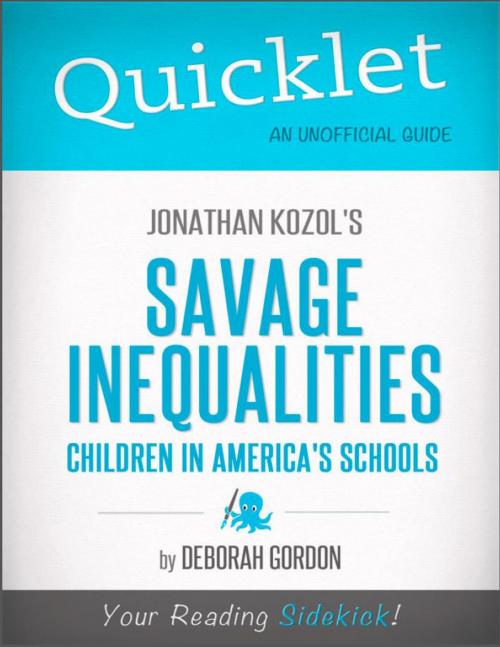Quicklet on Jonathan Kozol's Savage Inequalities: Children in America's Schools
Nonfiction, Reference & Language, Study Aids, Book Notes, Art & Architecture, General Art| Author: | Deborah Gordon | ISBN: | 9781614640806 |
| Publisher: | Hyperink | Publication: | March 14, 2012 |
| Imprint: | Hyperink | Language: | English |
| Author: | Deborah Gordon |
| ISBN: | 9781614640806 |
| Publisher: | Hyperink |
| Publication: | March 14, 2012 |
| Imprint: | Hyperink |
| Language: | English |
ABOUT THE BOOK
"Raw sewage" and "jail" may not be the first words that come to mind in terms of what might be found in a treatise on public school funding. Yet, these terms, along with privilege, poverty, racism, injustice, wealth, and equity/inequity, sum up the major themes of "Savage Inequalities: Children in America's Schools," one of nearly a dozen books about the state of American public school education by Jonathan Kozol.
The book was researched and written in the late 1980's and published in 1991 as the seventh in Kozol's ongoing critique of the myriad failures of education of American children, particularly children born into poverty. "Savage Inequalities" focuses on funding disparities between urban schools in the North, South, East and Midwest regions of the USA, and the lifetime impact these disparities have on the students, the teachers and the communities. These factors almost ensure, to use Kozol's phrasing, that the generals' children will have the option (and implied likelihood) of becoming generals, and the soldiers' children will only become soldiers, and only if they survive their public school experience.
Kozol, a former teacher, and writer, spent nearly three years traveling around the United States, visiting public schools, and talking with then current and former students, teachers, principals, district administrators and students' families. He observed classes and describes (often in painful detail) the facilities, and the communities in the school. He enumerates, again and again throughout the book about, the canyon-sized gaps in per-pupil spending between schools and districts that serve the children of the wealthy, who are most often white, and those that serve the children of the poor, who are most often black and Latino. Although, a school serving Appalachian children is also included among the under-served.
MEET THE AUTHOR
Deborah is a lifelong writer, non-violence activist, artist, voracious reader, public school teacher and world traveler and practical optimist. She lives by Thoreau's epigrammatic suggestion, "Go confidently in the direction of your dreams. Live the life you have imagined...."
After growing up in a suburb of New York City, she moved to the San Francisco Bay Area, where she has lived since 1977. By day, Deborah teaches high school in Oakland, and when not at school, she makes it a point to enjoy the moveable feast (with apologies to Hemingway) offered up here every day.
She attended San Francisco State and Cal State East Bay/Hayward, which resulted in degrees in art and education, as well as a couple of teaching credentials.
EXCERPT FROM THE BOOK
"Savage Inequalities: Children in America's Schools" is a book about numbers more than about children. However, children's voices, as well as the voices of other school staff, are heard throughout. But the numbers are the foundation of the story: numbers of dollars spent in wealthy districts, the smaller number spent in poor districts, numbers of students in classes, tax rates, high school dropout rates, test scores, teacher salaries, attrition rate of teachers, percentages of graduates and non-graduates, the size of the senior class vs. the freshman class, length of tenure of school principals and superintendents, rates of teen age pregnancies. But most often repeated figure is the amount of funding per pupil here as opposed to there, and the resultant regrettable conditions that follow.
As Kozol travels from East St. Louis to Chicago, from Philadelphia to New York City, from Camden (New Jersey) to Detroit, from San Antonio to Washington D.C, the portrait of schools serving predominantly/exclusively African American and Latino children, is a bleak and heart-breaking. He portrays school buildings whose walls are literally crumbling, scores of classrooms without teachers, classes without classrooms, and resources so inadequate that there are not even enough texts for each student to have during class...
ABOUT THE BOOK
"Raw sewage" and "jail" may not be the first words that come to mind in terms of what might be found in a treatise on public school funding. Yet, these terms, along with privilege, poverty, racism, injustice, wealth, and equity/inequity, sum up the major themes of "Savage Inequalities: Children in America's Schools," one of nearly a dozen books about the state of American public school education by Jonathan Kozol.
The book was researched and written in the late 1980's and published in 1991 as the seventh in Kozol's ongoing critique of the myriad failures of education of American children, particularly children born into poverty. "Savage Inequalities" focuses on funding disparities between urban schools in the North, South, East and Midwest regions of the USA, and the lifetime impact these disparities have on the students, the teachers and the communities. These factors almost ensure, to use Kozol's phrasing, that the generals' children will have the option (and implied likelihood) of becoming generals, and the soldiers' children will only become soldiers, and only if they survive their public school experience.
Kozol, a former teacher, and writer, spent nearly three years traveling around the United States, visiting public schools, and talking with then current and former students, teachers, principals, district administrators and students' families. He observed classes and describes (often in painful detail) the facilities, and the communities in the school. He enumerates, again and again throughout the book about, the canyon-sized gaps in per-pupil spending between schools and districts that serve the children of the wealthy, who are most often white, and those that serve the children of the poor, who are most often black and Latino. Although, a school serving Appalachian children is also included among the under-served.
MEET THE AUTHOR
Deborah is a lifelong writer, non-violence activist, artist, voracious reader, public school teacher and world traveler and practical optimist. She lives by Thoreau's epigrammatic suggestion, "Go confidently in the direction of your dreams. Live the life you have imagined...."
After growing up in a suburb of New York City, she moved to the San Francisco Bay Area, where she has lived since 1977. By day, Deborah teaches high school in Oakland, and when not at school, she makes it a point to enjoy the moveable feast (with apologies to Hemingway) offered up here every day.
She attended San Francisco State and Cal State East Bay/Hayward, which resulted in degrees in art and education, as well as a couple of teaching credentials.
EXCERPT FROM THE BOOK
"Savage Inequalities: Children in America's Schools" is a book about numbers more than about children. However, children's voices, as well as the voices of other school staff, are heard throughout. But the numbers are the foundation of the story: numbers of dollars spent in wealthy districts, the smaller number spent in poor districts, numbers of students in classes, tax rates, high school dropout rates, test scores, teacher salaries, attrition rate of teachers, percentages of graduates and non-graduates, the size of the senior class vs. the freshman class, length of tenure of school principals and superintendents, rates of teen age pregnancies. But most often repeated figure is the amount of funding per pupil here as opposed to there, and the resultant regrettable conditions that follow.
As Kozol travels from East St. Louis to Chicago, from Philadelphia to New York City, from Camden (New Jersey) to Detroit, from San Antonio to Washington D.C, the portrait of schools serving predominantly/exclusively African American and Latino children, is a bleak and heart-breaking. He portrays school buildings whose walls are literally crumbling, scores of classrooms without teachers, classes without classrooms, and resources so inadequate that there are not even enough texts for each student to have during class...















